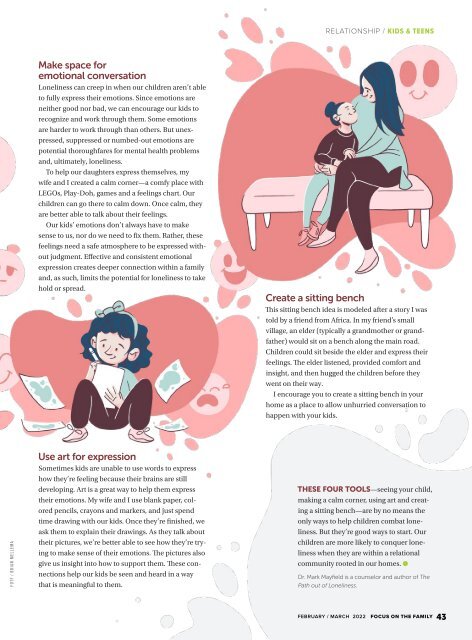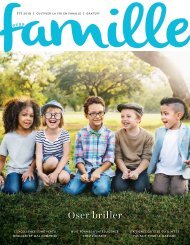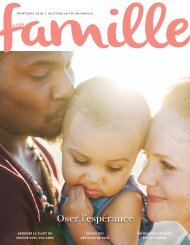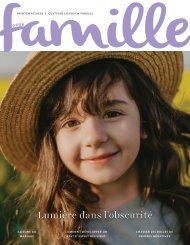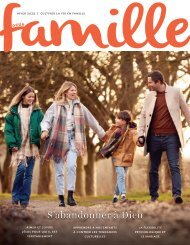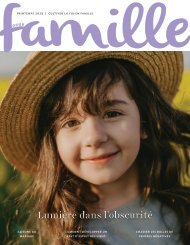Focus on the Family Magazine - February/March 2022
It can be a struggle to raise a family while balancing your work life, social life and relationships. Focus on the Family magazine is here to help! Each complimentary issue delivers fresh, practical Biblical guidance on family and life topics. Every issue comes packed with relevant advice to build up your kids, strengthen your marriage, navigate entertainment and culture, and handle common challenges you may face in your marriage and parenting journeys. Plus you'll find seasonal advice ranging from back-to-school activities to date night tips for you and your spouse.
It can be a struggle to raise a family while balancing your work life, social life and relationships. Focus on the Family magazine is here to help! Each complimentary issue delivers fresh, practical Biblical guidance on family and life topics.
Every issue comes packed with relevant advice to build up your kids, strengthen your marriage, navigate entertainment and culture, and handle common challenges you may face in your marriage and parenting journeys. Plus you'll find seasonal advice ranging from back-to-school activities to date night tips for you and your spouse.
- No tags were found...
Create successful ePaper yourself
Turn your PDF publications into a flip-book with our unique Google optimized e-Paper software.
RELATIONSHIP / KIDS & TEENS<br />
Make space for<br />
emoti<strong>on</strong>al c<strong>on</strong>versati<strong>on</strong><br />
L<strong>on</strong>eliness can creep in when our children aren’t able<br />
to fully express <strong>the</strong>ir emoti<strong>on</strong>s. Since emoti<strong>on</strong>s are<br />
nei<strong>the</strong>r good nor bad, we can encourage our kids to<br />
recognize and work through <strong>the</strong>m. Some emoti<strong>on</strong>s<br />
are harder to work through than o<strong>the</strong>rs. But unexpressed,<br />
suppressed or numbed-out emoti<strong>on</strong>s are<br />
potential thoroughfares for mental health problems<br />
and, ultimately, l<strong>on</strong>eliness.<br />
To help our daughters express <strong>the</strong>mselves, my<br />
wife and I created a calm corner—a comfy place with<br />
LEGOs, Play-Doh, games and a feelings chart. Our<br />
children can go <strong>the</strong>re to calm down. Once calm, <strong>the</strong>y<br />
are better able to talk about <strong>the</strong>ir feelings.<br />
Our kids’ emoti<strong>on</strong>s d<strong>on</strong>’t always have to make<br />
sense to us, nor do we need to fix <strong>the</strong>m. Ra<strong>the</strong>r, <strong>the</strong>se<br />
feelings need a safe atmosphere to be expressed without<br />
judgment. Effective and c<strong>on</strong>sistent emoti<strong>on</strong>al<br />
expressi<strong>on</strong> creates deeper c<strong>on</strong>necti<strong>on</strong> within a family<br />
and, as such, limits <strong>the</strong> potential for l<strong>on</strong>eliness to take<br />
hold or spread.<br />
Create a sitting bench<br />
This sitting bench idea is modeled after a story I was<br />
told by a friend from Africa. In my friend’s small<br />
village, an elder (typically a grandmo<strong>the</strong>r or grandfa<strong>the</strong>r)<br />
would sit <strong>on</strong> a bench al<strong>on</strong>g <strong>the</strong> main road.<br />
Children could sit beside <strong>the</strong> elder and express <strong>the</strong>ir<br />
feelings. The elder listened, provided comfort and<br />
insight, and <strong>the</strong>n hugged <strong>the</strong> children before <strong>the</strong>y<br />
went <strong>on</strong> <strong>the</strong>ir way.<br />
I encourage you to create a sitting bench in your<br />
home as a place to allow unhurried c<strong>on</strong>versati<strong>on</strong> to<br />
happen with your kids.<br />
FOTF / BRIAN MELLEMA<br />
Use art for expressi<strong>on</strong><br />
Sometimes kids are unable to use words to express<br />
how <strong>the</strong>y’re feeling because <strong>the</strong>ir brains are still<br />
developing. Art is a great way to help <strong>the</strong>m express<br />
<strong>the</strong>ir emoti<strong>on</strong>s. My wife and I use blank paper, colored<br />
pencils, cray<strong>on</strong>s and markers, and just spend<br />
time drawing with our kids. Once <strong>the</strong>y’re finished, we<br />
ask <strong>the</strong>m to explain <strong>the</strong>ir drawings. As <strong>the</strong>y talk about<br />
<strong>the</strong>ir pictures, we’re better able to see how <strong>the</strong>y’re trying<br />
to make sense of <strong>the</strong>ir emoti<strong>on</strong>s. The pictures also<br />
give us insight into how to support <strong>the</strong>m. These c<strong>on</strong>necti<strong>on</strong>s<br />
help our kids be seen and heard in a way<br />
that is meaningful to <strong>the</strong>m.<br />
THESE FOUR TOOLS—seeing your child,<br />
making a calm corner, using art and creating<br />
a sitting bench—are by no means <strong>the</strong><br />
<strong>on</strong>ly ways to help children combat l<strong>on</strong>eliness.<br />
But <strong>the</strong>y’re good ways to start. Our<br />
children are more likely to c<strong>on</strong>quer l<strong>on</strong>eliness<br />
when <strong>the</strong>y are within a relati<strong>on</strong>al<br />
community rooted in our homes. •<br />
Dr. Mark Mayfield is a counselor and author of The<br />
Path out of L<strong>on</strong>eliness.<br />
FEBRUARY / MARCH <strong>2022</strong> FOCUS ON THE FAMILY 43


